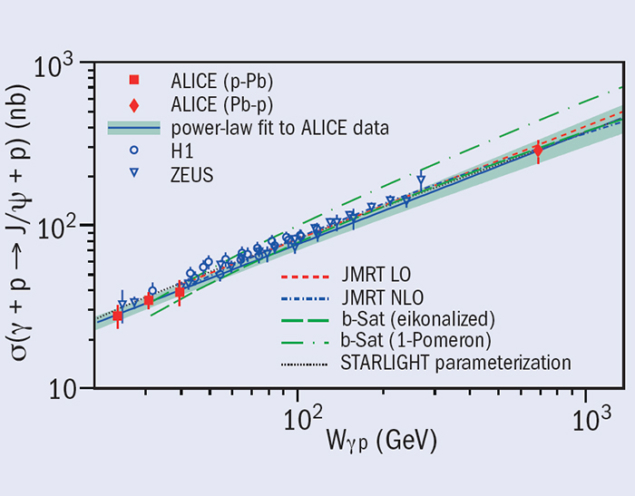The electric charge of lead ions, when accelerated to ultra-relativistic velocities, is the source of an intense flux of high-energy quasi-real photons. Ultra-peripheral collisions – the interaction of a photon with a target at impact parameters larger than the sum of the radii of the incoming particles, where hadronic interactions are suppressed – provide a clean tool to study photon-induced production processes at the LHC.

ALICE has performed the first measurement of exclusive photoproduction of J/ψ mesons off protons in proton–lead collisions at the LHC, using data collected in early 2013 (Abelev et al. 2014). These data cover a range of photon–proton centre-of-mass energies that were not accessible previously. Such interactions have been studied at the electron–proton collider HERA, and are proposed as a key measurement at a future electron–hadron collider, to probe the gluon distribution in the proton.
The J/ψ mesons were reconstructed from their decay into a μ+μ– pair, where the muons were measured by the ALICE muon spectrometer. Requiring no other activity to be present in the detector enforced the exclusivity condition. Around the middle of the data-taking period, the beam direction was inverted, allowing ALICE to take data first when protons, and later lead ions, were travelling towards the muon spectrometer, providing proton–lead and lead–proton collisions, respectively. The rapidity of the J/ψ, measured with respect to the direction of the proton beam, determines the photon–proton centre of mass energy (Wγp). In lead–proton collisions, the acceptance of ALICE corresponds to values of Wγp more than twice as large as was reached at HERA by the H1 and ZEUS experiments, while the proton–lead collisions correspond to values of Wγp studied previously at HERA and in fixed-target experiments.
According to leading-order calculations in perturbative QCD, this process depends on the square of the gluon distribution in the proton evaluated at a scale close to the J/ψ mass (MJ/ψ) and at x-Bjorken x = (MJ/ψ/Wγp)2. The range in x covered by ALICE therefore extends from about 2 × 10–2 (proton–lead) to 2 × 10–5 (lead–proton). It is then possible to study the evolution of the gluon density in the proton at a perturbative scale along three orders of magnitude in x, and probe into the region where the gluon density increases, possibly leading to a saturation regime, in which the proton wave-function is described by a coherent colour field created by the many overlapping gluons.
The cross-section measured by ALICE (see figure) has been compared with the predictions of models based on (i) perturbative QCD calculations at leading order (ii) and including the main next-to-leading order contributions, (iii) a saturation prescription including impact parameter dependence and (iv) a parameterization of HERA and fixed-target results. All models were fitted to HERA measurements, and are able to describe the current ALICE data.
ALICE has found that a power law in Wγp can describe the measured cross-section. The value of the power-law exponent is compatible with those found by H1 and by ZEUS. Therefore, no deviation from the same power law is observed up to about 700 GeV, or in a leading-order perturbative QCD context, down to x = 2 × 10–5, extending by a factor five the maximum x value explored previously.
In conclusion, within the current precision, ALICE has observed no change of regime with respect to what was measured at HERA. Data to be collected during LHC Run 2 at beam energies increased by a factor of two will allow ALICE both to improve the precision of the measurement and to access larger values of Wγp. Lowering the x value to values never reached before will open new opportunities to search for saturation phenomena.
Further reading
B B Abelev et al. (ALICE Collaboration) 2014 arXiv:1406.7819 [nucl-ex], accepted by Phys. Rev. Lett.





